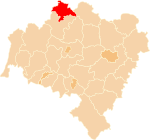Collegiate Church of the Assumption of the Blessed Virgin Mary in Głogów
11th-century establishments in PolandBurial sites of the Piast dynastyChurches in Lower Silesian VoivodeshipCollegiate Gothic architectureGothic architecture in Poland ... and 1 more
Romanesque architecture in Poland

The Collegiate Church of the Assumption of the Blessed Virgin Mary in Głogów is a Roman Catholic church located in the parish of the Assumption of the Blessed Virgin Mary, in Głogów, Poland, within the Diocese of Zielona Góra-Gorzów. It rises above the oldest district of Głogów, Ostrów Tumski. It is currently undergoing reconstruction after damage sustained during World War II. Built in the Romanesque and Gothic styles, it is one of the oldest churches in Silesia and the oldest collegiate church in Silesia. Its origins date back to the first Polish monarchs from the Piast dynasty.
Excerpt from the Wikipedia article Collegiate Church of the Assumption of the Blessed Virgin Mary in Głogów (License: CC BY-SA 3.0, Authors, Images).Collegiate Church of the Assumption of the Blessed Virgin Mary in Głogów
Plac Kolegiacki,
Geographical coordinates (GPS) Address External links Nearby Places Show on map
Geographical coordinates (GPS)
| Latitude | Longitude |
|---|---|
| N 51.670555555556 ° | E 16.093888888889 ° |
Address
Kolegiata Wniebowzięcia Najświętszej Maryi Panny
Plac Kolegiacki 1
67-200 , Ostrów Tumski
Lower Silesian Voivodeship, Poland
Open on Google Maps






